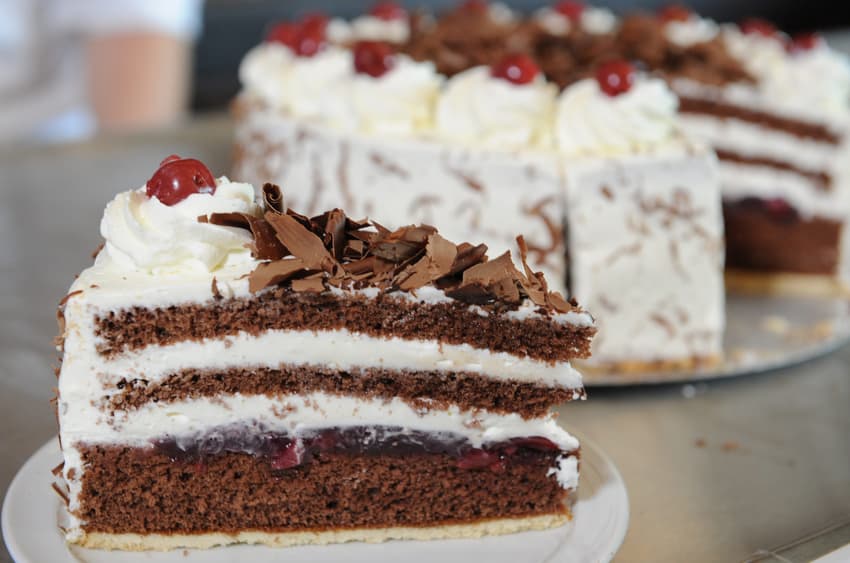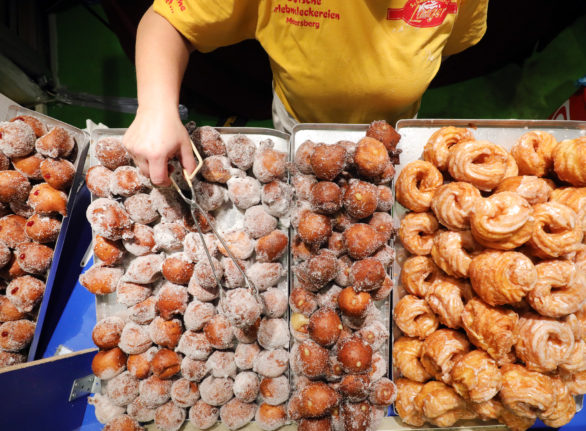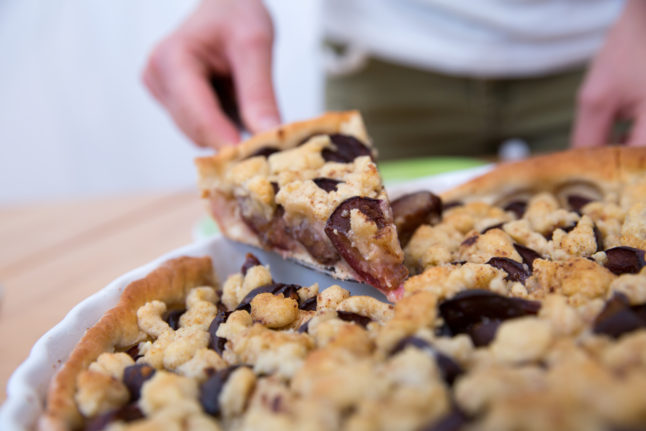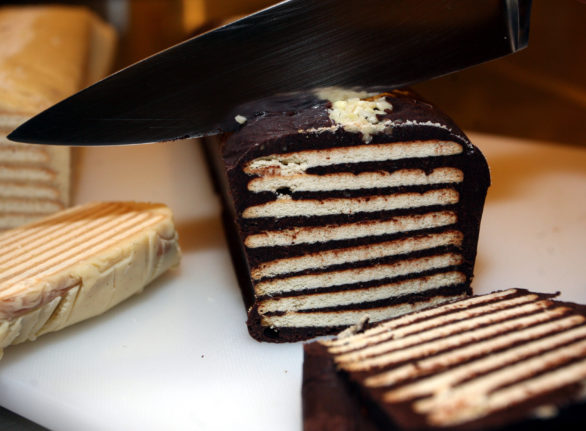10 classic sweet treats to try at least once in Germany

Kaffee und Kuchen - or coffee and cake - is a strong German tradition. So of course there is a huge selection of sweet treats across the country. Here's 10 that we think you should try.
Bienenstich
Despite its slightly disturbing name, the "bee sting cake" is a much-loved favourite in Germany, and you'll find it in almost every bakery. It's absolutely delicious and is likely to become one of your top choices for a Kaffee und Kuchen Pause (coffee and cake break). Components of this classic are a sweet yeast dough, a filling of vanilla or cream, honey and a topping of flaked almonds that caramelises during baking.
It also has an interesting back story. According to legend, a feud between the towns of Andernach and Linz escalated into violence when the former was attacked by the latter. However, the residents of Andernach managed to fend the residents of Linz off by throwing beehives at the attackers, who promptly fled. To celebrate the event, the people of Andernach invented the cake and named it after the event which inspired it.
View this post on Instagram
Spritzkuchen
A specialty of Eberswalde, in north-eastern Germany, the Spritzkuchen is a bit like a sugar-glazed donut, but with a slightly different texture. The trick is that the dough gets cooked while the ingredients are mixed before it's fried. These treats are said to have originated in 1832 in the town of Eberswalde in Brandenburg near Berlin.

A server with Spritzkuchen (on the right) and doughnuts during a food event in Berlin in 2018. Photo: picture alliance / Wolfgang Kumm/dpa | Wolfgang Kumm
READ ALSO: Kaffee und Kuchen - the history behind a very German tradition
Pflaumenkuchen
July through to October is plum season in Germany, so it's the perfect time to get your hands on a slice of Pflaumenkuchen or "plum cake". Bakeries are often lined with quartered plums called Zwetschgen nestled together on the delicious base. It's also sometimes known as Zwetschgenkuchen.

Pflaumenkuchen or plum cake being served. Photo: picture alliance/dpa/dpa-tmn | Florian Schuh
Schwarzwälder Kirschtorte
It's hard to compile a roundup of German deserts without mentioning the famous "black forest cake" or "gâteau" (pictured at the top of the article).
This delicious treat is considered one of the most popular German cakes and is known around the world. It typically consists of several layers of chocolate sponge with whipped cream and cherries. It also has whipped cream, maraschino cherries and chocolate shavings on top.
If a dessert is labelled as Schwarzwälder Kirschtorte, then under German law it has to contain Kirschwasser, a brandy made from the distillation of morello cherries.
READ ALSO: A guide to the best international supermarkets in Berlin
Frankfurter Kranz
Frankfurt's speciality is the Frankfurter Kranz or "wreath". This Bundt cake (baked in a Bundt pan) is typically layered with jam and buttercream and sprinkled with caramelised nuts.
View this post on Instagram
Donauwelle
The Donauwelle or "Danube wave" likely gets its name from the wave-like pattern on this yummy sweet treat. This cake has layers of plain and chocolate pound cake combined and contains sour cherries. It's usually topped with buttercream and chocolate glaze. The Donauwelle is baked on a sheet pan and then cut into rectangular pieces and served.
View this post on Instagram
Käsekuchen
Germans love their cheesecake. The classic German Käsekuchen is made with Quark cheese, unlike the American type which uses cream cheese. The base is usually made of a shortcrust pastry, but there are quite different variants, such as bottomless cheesecake and variants with berries or other fruit.
View this post on Instagram
Prinzregententorte
If you're in Bavaria, make sure to try out the Prinzregententorte, which is a torte consisting of at least six - and usually seven - thin layers of sponge cake interlaid with chocolate buttercream.
View this post on Instagram
Kalter Hund
The Kalter Hund - or "cold dog" is actually nothing to do with dogs. It's a chocolate-style no-bake dessert that no doubt brings back sweet childhood memories back to many Germans. The Kalter Hund is generally made with a cocoa coconut fat cream and butter biscuits. The biscuits are layered in a loaf pan and spread with the cocoa cream.

Germany's Kalter Hund dessert being sliced up. Photo: picture alliance/dpa | Stephanie Pilick
Hefezopf
The Hefezopf, which literally means "yeast wreath" or "yeast braid" is a sweet bread popular in German-speaking countries and often in different variations across Europe. It's a staple at Easter brunch with the family. The sweet yeast dough is divided into three parts, rolled into long "sausages" and then braided into a plait. Last but not least, it is brushed with a little milk and sprinkled with sugar before going into the oven.
View this post on Instagram
Comments
See Also
Bienenstich
Despite its slightly disturbing name, the "bee sting cake" is a much-loved favourite in Germany, and you'll find it in almost every bakery. It's absolutely delicious and is likely to become one of your top choices for a Kaffee und Kuchen Pause (coffee and cake break). Components of this classic are a sweet yeast dough, a filling of vanilla or cream, honey and a topping of flaked almonds that caramelises during baking.
It also has an interesting back story. According to legend, a feud between the towns of Andernach and Linz escalated into violence when the former was attacked by the latter. However, the residents of Andernach managed to fend the residents of Linz off by throwing beehives at the attackers, who promptly fled. To celebrate the event, the people of Andernach invented the cake and named it after the event which inspired it.
View this post on Instagram
Spritzkuchen
A specialty of Eberswalde, in north-eastern Germany, the Spritzkuchen is a bit like a sugar-glazed donut, but with a slightly different texture. The trick is that the dough gets cooked while the ingredients are mixed before it's fried. These treats are said to have originated in 1832 in the town of Eberswalde in Brandenburg near Berlin.

READ ALSO: Kaffee und Kuchen - the history behind a very German tradition
Pflaumenkuchen
July through to October is plum season in Germany, so it's the perfect time to get your hands on a slice of Pflaumenkuchen or "plum cake". Bakeries are often lined with quartered plums called Zwetschgen nestled together on the delicious base. It's also sometimes known as Zwetschgenkuchen.

Schwarzwälder Kirschtorte
It's hard to compile a roundup of German deserts without mentioning the famous "black forest cake" or "gâteau" (pictured at the top of the article).
This delicious treat is considered one of the most popular German cakes and is known around the world. It typically consists of several layers of chocolate sponge with whipped cream and cherries. It also has whipped cream, maraschino cherries and chocolate shavings on top.
If a dessert is labelled as Schwarzwälder Kirschtorte, then under German law it has to contain Kirschwasser, a brandy made from the distillation of morello cherries.
READ ALSO: A guide to the best international supermarkets in Berlin
Frankfurter Kranz
Frankfurt's speciality is the Frankfurter Kranz or "wreath". This Bundt cake (baked in a Bundt pan) is typically layered with jam and buttercream and sprinkled with caramelised nuts.
View this post on Instagram
Donauwelle
The Donauwelle or "Danube wave" likely gets its name from the wave-like pattern on this yummy sweet treat. This cake has layers of plain and chocolate pound cake combined and contains sour cherries. It's usually topped with buttercream and chocolate glaze. The Donauwelle is baked on a sheet pan and then cut into rectangular pieces and served.
View this post on Instagram
Käsekuchen
Germans love their cheesecake. The classic German Käsekuchen is made with Quark cheese, unlike the American type which uses cream cheese. The base is usually made of a shortcrust pastry, but there are quite different variants, such as bottomless cheesecake and variants with berries or other fruit.
View this post on Instagram
Prinzregententorte
If you're in Bavaria, make sure to try out the Prinzregententorte, which is a torte consisting of at least six - and usually seven - thin layers of sponge cake interlaid with chocolate buttercream.
View this post on Instagram
Kalter Hund
The Kalter Hund - or "cold dog" is actually nothing to do with dogs. It's a chocolate-style no-bake dessert that no doubt brings back sweet childhood memories back to many Germans. The Kalter Hund is generally made with a cocoa coconut fat cream and butter biscuits. The biscuits are layered in a loaf pan and spread with the cocoa cream.

Hefezopf
The Hefezopf, which literally means "yeast wreath" or "yeast braid" is a sweet bread popular in German-speaking countries and often in different variations across Europe. It's a staple at Easter brunch with the family. The sweet yeast dough is divided into three parts, rolled into long "sausages" and then braided into a plait. Last but not least, it is brushed with a little milk and sprinkled with sugar before going into the oven.
View this post on Instagram
Join the conversation in our comments section below. Share your own views and experience and if you have a question or suggestion for our journalists then email us at [email protected].
Please keep comments civil, constructive and on topic – and make sure to read our terms of use before getting involved.
Please log in here to leave a comment.